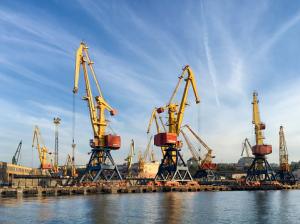Port Infrastructure Market Expected to Reach USD 315.14 Billion by 2034, with a CAGR of 4.33% | MRFR
Increased global trade Technological advancements Infrastructure modernization Emergence of smart ports Growing demand for green ports
NY, UNITED STATES, April 29, 2025 /EINPresswire.com/ -- The port infrastructure market stands as a critical pillar of global trade, acting as the gateway through which goods flow between nations. As globalization deepens and maritime trade intensifies, the demand for modern, efficient, and sustainable port facilities continues to grow. Valued at billions of dollars and expanding steadily, the port infrastructure market is experiencing transformation driven by technological innovation, environmental regulation, and geopolitical developments.The Port Infrastructure market was valued at USD 206.22 billion in 2024. It is projected to grow from USD 215.15 billion in 2025 to USD 315.14 billion by 2034, registering a compound annual growth rate (CAGR) of approximately 4.33% during the forecast period (2025–2034).
Port infrastructure encompasses a broad array of facilities and services, including berths, cranes, container terminals, storage warehouses, logistics zones, and intermodal connections. These elements support the handling, storage, and distribution of cargo, passengers, and vehicles.
The market is segmented based on port type (sea ports, inland ports, dry ports), infrastructure type (container terminals, bulk terminals, general cargo terminals, etc.), and end-user industries (oil and gas, automotive, agriculture, retail, and manufacturing). With international seaborne trade accounting for over 80% of the volume of global trade, investment in port infrastructure is essential for sustaining and enhancing trade performance.
Get Free Sample Copy of Port Infrastructure Market Report @ https://www.marketresearchfuture.com/sample_request/28403
Growth Drivers
1. Rising Global Trade and Containerization
The explosion of international trade—especially between Asia, Europe, and North America—has led to a surge in demand for larger, more advanced port infrastructure. The trend of containerization, which standardizes cargo handling and boosts efficiency, has particularly driven investments in container ports with specialized cranes, automation systems, and digital tracking.
2. Urbanization and Industrialization
Emerging economies in Asia, Africa, and Latin America are experiencing rapid urbanization and industrial development. To facilitate exports and imports of raw materials and finished goods, governments and private investors are channeling funds into new port facilities and expanding existing ones.
3. Technological Advancements
The integration of digital technologies is reshaping port operations. Smart ports now employ Internet of Things (IoT), artificial intelligence (AI), blockchain, and automation to streamline logistics, reduce turnaround time, and minimize human error. Ports like Rotterdam, Singapore, and Hamburg are examples of digitally integrated hubs that serve as models for future infrastructure.
4. Belt and Road Initiative (BRI)
China’s BRI is one of the largest infrastructure projects in history and has significantly influenced global port development. By investing in ports across Asia, Africa, and Europe, China aims to secure trade routes and influence global supply chains. This has led to massive upgrades in ports like Gwadar (Pakistan), Piraeus (Greece), and Djibouti.
Challenges
1. Environmental Concerns
Port infrastructure projects can have significant environmental impacts, including coastal erosion, marine pollution, and carbon emissions. Stricter regulations and community opposition can delay projects and increase costs. As a result, there is growing demand for “green ports” that use renewable energy, electrified equipment, and sustainable construction practices.
2. High Capital Requirements
Developing modern port infrastructure is capital-intensive, often involving multi-billion-dollar investments. Public-private partnerships (PPPs) are increasingly being used to mitigate financial risk, though aligning the interests of stakeholders can be complex.
3. Geopolitical Risks and Trade Tensions
Ports are not immune to geopolitical dynamics. Trade wars, sanctions, and territorial disputes can disrupt investment plans and shipping routes. For instance, tensions in the South China Sea or Red Sea have strategic implications for port accessibility and security.
BUY NOW Report @ https://www.marketresearchfuture.com/checkout?currency=one_user-USD&report_id=28403
Regional Insights
Asia-Pacific leads the global port infrastructure market, driven by powerhouse economies like China, India, and Southeast Asian nations. China alone is home to several of the world’s largest ports, including Shanghai, Ningbo-Zhoushan, and Shenzhen.
Europe has been focusing on green transition and automation. Ports like Rotterdam are investing in hydrogen fuel infrastructure and AI-driven logistics to reduce emissions and improve efficiency.
North America is undergoing significant upgrades, especially in the U.S., where ports such as Los Angeles and Long Beach are facing congestion and outdated facilities. Infrastructure bills and federal funding are supporting modernization efforts.
Middle East and Africa are emerging as strategic logistics hubs, with countries like the UAE, Saudi Arabia, and Egypt investing heavily in port expansion to diversify economies and capitalize on trade routes.
Browse In-Depth Market Research Report: https://www.marketresearchfuture.com/reports/port-infrastructure-market-28403
Key Companies in the Port Infrastructure Market Include
Port of Oakland
PSA International
Hutchison Ports
Shanghai International Port Group
Port of Hamburg
Port of Los Angeles
Port of Antwerp
Port of Tanjung Pelepas
Port of Rotterdam
COSCO Shipping Ports
Future Outlook
Digitalization and Smart Port Development: The adoption of AI, IoT, and blockchain for port management.
Sustainability: Increased focus on reducing the environmental footprint of port operations.
Resilience and Redundancy: Building infrastructure that can withstand climate change impacts and supply chain shocks.
Multi-Modal Integration: Enhancing connectivity between ports, railways, roads, and airports to streamline cargo movement.
Governments and private stakeholders alike must prioritize adaptive planning, technological investments, and sustainable practices to ensure that port infrastructure keeps pace with the demands of global commerce.
Related Reports:
Cylindrical Grinder Market https://www.marketresearchfuture.com/reports/cylindrical-grinder-market-37326
Tray Former Machine Market https://www.marketresearchfuture.com/reports/tray-former-machine-market-38384
Downhole Equipment Market https://www.marketresearchfuture.com/reports/downhole-equipment-market-39944
Electronic Discharge Machining Edm Market https://www.marketresearchfuture.com/reports/electronic-discharge-machining-market-39779
Fhp Motors Market https://www.marketresearchfuture.com/reports/fhp-motors-market-39965
Floating Docks Market https://www.marketresearchfuture.com/reports/floating-docks-market-39927
Market Research Future
Market Research Future
+16282580071 ext.
email us here
Visit us on social media:
Facebook
X
LinkedIn
Legal Disclaimer:
EIN Presswire provides this news content "as is" without warranty of any kind. We do not accept any responsibility or liability for the accuracy, content, images, videos, licenses, completeness, legality, or reliability of the information contained in this article. If you have any complaints or copyright issues related to this article, kindly contact the author above.
Commit to UK: Ushering in a Bold New Era of Tech Innovation and Empowering Startups
Xraised Interviews Nemika Menevse: Driving Innovation in BNPL and Championing Gender Equality in Business
Finding Faith in Life’s Unexpected Turns: Lynn Assimacopoulos Offers Humor, Heart, and Hope
Kalendarium
Więcej ważnych informacji
 Jedynka Newserii
Jedynka Newserii

 Jedynka Newserii
Jedynka Newserii

Ochrona środowiska

Zielona transformacja wiąże się z dodatkowymi kosztami. Mimo to firmy traktują ją jako szansę dla siebie i Europy
Bez zaangażowania największych firm, które ograniczają własny ślad węglowy, będzie trudno o transformację energetyczną. Jak wynika z danych Europejskiego Banku Inwestycyjnego, w ubiegłym roku 61 proc. przedsiębiorstw z UE zainwestowało w walkę ze zmianą klimatu. Choć z tymi inwestycjami wiążą się zwykle ogromne koszty, część firm traktuje je jako szansę na podniesienie swojej konkurencyjności. Wśród znaczących korzyści podnoszą też kwestię zmniejszania zależności od dostaw surowców energetycznych z innych krajów.
Prawo
Rolnicy z Wielkopolski i Opolszczyzny protestują przeciwko likwidacji ich miejsc pracy. Minister rolnictwa deklaruje szukanie rozwiązań

W czwartek 24 kwietnia pracownicy towarowych gospodarstw rolnych z województw wielkopolskiego i opolskiego protestowali przed Ministerstwem Rolnictwa i Rozwoju Wsi w Warszawie. To już kolejny – po poznańskim – protest, który ma zwrócić uwagę na opieszałość urzędników w związku z zagospodarowaniem zwracanych do Zasobu Skarbu Państwa dzierżawionych gruntów, na których dziś prowadzona jest działalność rolnicza. Minister Czesław Siekierski przyjął delegację pracowników, która przekazała petycję z postulatami wymagającymi pilnych działań urzędniczych.
Prawo
W połowie maja pierwszym pakietem deregulacyjnym zajmie się Senat. Trwają prace nad drugim pakietem

Zgodnie z zaplanowanym porządkiem obrad na posiedzeniu 14–15 maja Senat zajmie się pierwszym pakietem deregulacyjnym, przygotowanym przez Ministerstwo Rozwoju i Technologii. Przyjęty w ubiegłym tygodniu przez Sejm dokument zawiera około 40 rozwiązań, które mają ułatwić prowadzenie biznesu. W ciągu kilku miesięcy efekty mają być odczuwalne dla przedsiębiorców. Jednocześnie trwają już prace nad kolejnymi propozycjami deregulacyjnymi.
Partner serwisu
Szkolenia

Akademia Newserii
Akademia Newserii to projekt, w ramach którego najlepsi polscy dziennikarze biznesowi, giełdowi oraz lifestylowi, a także szkoleniowcy z wieloletnim doświadczeniem dzielą się swoją wiedzą nt. pracy z mediami.





![Europejskie miasta planują wzrost inwestycji w infrastrukturę społeczną. Wydatki na niskoemisyjny transport wciąż są niewystarczające [DEPESZA]](https://www.newseria.pl/files/1097841585/panel-dotacje-foto,w_85,_small.jpg)


.gif)

 |
| |
| |
|